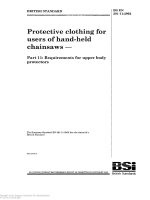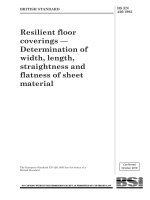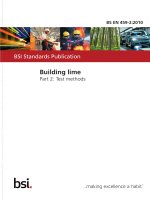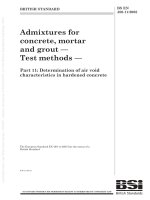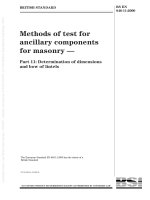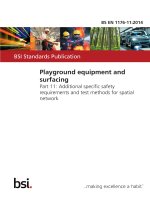Bsi bs en 61937 11 2010
Bạn đang xem bản rút gọn của tài liệu. Xem và tải ngay bản đầy đủ của tài liệu tại đây (1.38 MB, 20 trang )
Licensed Copy: Wang Bin, ISO/EXCHANGE CHINA STANDARDS, 25/10/2010 07:30, Uncontrolled Copy, (c) BSI
BS EN 61937-11:2010
BSI Standards Publication
Digital audio — Interface
for non-linear PCM encoded
audio bitstreams applying
IEC 60958
Part 11: MPEG-4 AAC and its extensions
in LATM/LOAS
NO COPYING WITHOUT BSI PERMISSION EXCEPT AS PERMITTED BY COPYRIGHT LAW
raising standards worldwide™
Licensed Copy: Wang Bin, ISO/EXCHANGE CHINA STANDARDS, 25/10/2010 07:30, Uncontrolled Copy, (c) BSI
BRITISH STANDARD
BS EN 61937-11:2010
National foreword
This British Standard is the UK implementation of EN 61937-11:2010. It is
identical to IEC 61937-11:2010.
The UK participation in its preparation was entrusted to Technical Committee
EPL/100, Audio, video and multimedia systems and equipment.
A list of organizations represented on this committee can be obtained on
request to its secretary.
This publication does not purport to include all the necessary provisions of a
contract. Users are responsible for its correct application.
© BSI 2010
ISBN 978 0 580 65708 5
ICS 33.160.30; 33.170
Compliance with a British Standard cannot confer immunity from
legal obligations.
This British Standard was published under the authority of the Standards
Policy and Strategy Committee on 31 July 2010.
Amendments issued since publication
Amd. No.
Date
Text affected
Licensed Copy: Wang Bin, ISO/EXCHANGE CHINA STANDARDS, 25/10/2010 07:30, Uncontrolled Copy, (c) BSI
BS EN 61937-11:2010
EUROPEAN STANDARD
EN 61937-11
NORME EUROPÉENNE
EUROPÄISCHE NORM
June 2010
ICS 33.160.30; 33.170
English version
Digital audio Interface for non-linear PCM encoded audio bitstreams applying
IEC 60958 Part 11: MPEG-4 AAC and its extensions in LATM/LOAS
(IEC 61937-11:2010)
Audionumérique Interface pour les flux de bits audio
à codage MIC non linéaire
conformément à la CEI 60958 Partie 11 : MPEG-4 AAC
et ses extensions en LATM/LOAS
(CEI 61937-11:2010)
Digitalton – Schnittstelle für nichtlinearPCM-codierte Audio-Bitströme
unter Verwendung von IEC 60958 –
Teil 11: MPEG-4-AAC
und dessen Erweiterungen in LATM/LOAS
(IEC 61937-11:2010)
This European Standard was approved by CENELEC on 2010-06-01. CENELEC members are bound to comply
with the CEN/CENELEC Internal Regulations which stipulate the conditions for giving this European Standard
the status of a national standard without any alteration.
Up-to-date lists and bibliographical references concerning such national standards may be obtained on
application to the Central Secretariat or to any CENELEC member.
This European Standard exists in three official versions (English, French, German). A version in any other
language made by translation under the responsibility of a CENELEC member into its own language and notified
to the Central Secretariat has the same status as the official versions.
CENELEC members are the national electrotechnical committees of Austria, Belgium, Bulgaria, Croatia, Cyprus,
the Czech Republic, Denmark, Estonia, Finland, France, Germany, Greece, Hungary, Iceland, Ireland, Italy,
Latvia, Lithuania, Luxembourg, Malta, the Netherlands, Norway, Poland, Portugal, Romania, Slovakia, Slovenia,
Spain, Sweden, Switzerland and the United Kingdom.
CENELEC
European Committee for Electrotechnical Standardization
Comité Européen de Normalisation Electrotechnique
Europäisches Komitee für Elektrotechnische Normung
Management Centre: Avenue Marnix 17, B - 1000 Brussels
© 2010 CENELEC -
All rights of exploitation in any form and by any means reserved worldwide for CENELEC members.
Ref. No. EN 61937-11:2010 E
Licensed Copy: Wang Bin, ISO/EXCHANGE CHINA STANDARDS, 25/10/2010 07:30, Uncontrolled Copy, (c) BSI
BS EN 61937-11:2010
EN 61937-11:2010
-2-
Foreword
The text of document 100/1491/CDV, future edition 1 of IEC 661937-11, prepared by IEC TC 100, Audio,
video and multimedia systems and equipment, was submitted to the IEC-CENELEC parallel vote and was
approved by CENELEC as EN 61937-11 on 2010-06-01.
Attention is drawn to the possibility that some of the elements of this document may be the subject of
patent rights. CEN and CENELEC shall not be held responsible for identifying any or all such patent
rights.
The following dates were fixed:
– latest date by which the EN has to be implemented
at national level by publication of an identical
national standard or by endorsement
(dop)
2011-03-01
– latest date by which the national standards conflicting
with the EN have to be withdrawn
(dow)
2013-06-01
Annex ZA has been added by CENELEC.
__________
Endorsement notice
The text of the International Standard IEC 61937-11:2010 was approved by CENELEC as a European
Standard without any modification.
In the official version, for Bibliography, the following notes have to be added for the standards indicated:
IEC 61937 series
NOTE Harmonized in EN 61937 series (not modified).
IEC 61937-6
NOTE Harmonized as EN 61937-6.
__________
Licensed Copy: Wang Bin, ISO/EXCHANGE CHINA STANDARDS, 25/10/2010 07:30, Uncontrolled Copy, (c) BSI
BS EN 61937-11:2010
EN 61937-11:2010
-3-
Annex ZA
(normative)
Normative references to international publications
with their corresponding European publications
The following referenced documents are indispensable for the application of this document. For dated
references, only the edition cited applies. For undated references, the latest edition of the referenced
document (including any amendments) applies.
NOTE When an international publication has been modified by common modifications, indicated by (mod), the relevant EN/HD
applies.
Publication
Year
IEC 60958
Title
EN/HD
Year
Series Digital audio interface
EN 60958
Series
IEC 61937-1
-
Digital audio - Interface for non-linear PCM
encoded audio bitstreams
applying IEC 60958 Part 1: General
EN 61937-1
-
IEC 61937-2
-
Digital audio - Interface for non-linear PCM
encoded audio bitstreams
applying IEC 60958 Part 2: Burst-info
EN 61937-2
-
ISO/IEC 14496-3
2009
Information technology - Coding of audiovisual objects Part 3: Audio
-
-
Licensed Copy: Wang Bin, ISO/EXCHANGE CHINA STANDARDS, 25/10/2010 07:30, Uncontrolled Copy, (c) BSI
BS EN 61937-11:2010
–2–
61937-11 © IEC:2010(E)
CONTENTS
INTRODUCTION.....................................................................................................................5
1
Scope ...............................................................................................................................6
2
Normative references .......................................................................................................6
3
Terms, definitions and abbreviations ................................................................................6
4
3.1 Terms and definitions ..............................................................................................6
3.2 Abbreviations ..........................................................................................................8
Mapping of the audio bit stream on to IEC 61937-1 ..........................................................8
5
4.1 General ...................................................................................................................8
4.2 Burst-info for MPEG-4 AAC and its extensions in LATM/LOAS ................................ 8
Format of data-burst for MPEG-4 AAC and its extensions in LATM/LOAS .........................9
5.1
5.2
5.3
General ...................................................................................................................9
Pause data-bursts for MPEG-4 AAC and its extensions in LATM/LOAS ...................9
Audio data-bursts .................................................................................................. 10
5.3.1 MPEG-4 AAC and its extensions in LATM/LOAS........................................ 10
5.3.2 LATM/LOAS framing .................................................................................. 12
5.3.3 Latency ..................................................................................................... 12
Annex A (informative) Calculation of delay and data-burst repetition rates, guidelines ......... 14
Bibliography.......................................................................................................................... 16
Figure 1 – Data-burst structure ............................................................................................. 10
Figure 2 – Latency diagram for burst reception and decoding ............................................... 13
Table 1 – Values for data-type and sub-data-type ...................................................................9
Table 2 – Repetition period of pause data-bursts ....................................................................9
Table 3 – Data-type-dependent information .......................................................................... 11
Table A.1 – Examples – Calculation of delay and data-burst repetition rates......................... 14
Licensed Copy: Wang Bin, ISO/EXCHANGE CHINA STANDARDS, 25/10/2010 07:30, Uncontrolled Copy, (c) BSI
BS EN 61937-11:2010
61937-11 © IEC:2010(E)
–5–
INTRODUCTION
Modern digital video broadcasting standards such as DVB include support for the MPEG-4
HE AAC and/or HE AAC v2 audio codecs as specified in ISO/IEC 14496-3. An increasing
number of countries are adopting these new codecs for their standard definition and high
definition digital video broadcasting services and have started with implementations.
For MPEG-2 AAC audio (ISO/IEC 13818-7) the specified framing format for the audio bit
stream is ADTS and its transport over an IEC 60958 interface is specified in IEC 61937-6.
However, the MPEG-4 (ISO/IEC 14496-3) audio codecs introduce new features and
capabilities that require a framing format that supports more flexible signaling and delivery
mechanisms. Therefore, MPEG-2 Systems (ISO/IEC 13818-1) specifies the MPEG-4
LATM/LOAS framing format for MPEG-4 audio codecs to overcome the limitations of ADTS.
In order to be able to pass the MPEG-4 audio bit stream from a Set Top Box to an A/V
receiver connected via the IEC 60958 interface without needing to reframe the audio bit
stream within ADTS, the MPEG-4 LATM/LOAS framing format needs to be supported by
IEC 61937.
Licensed Copy: Wang Bin, ISO/EXCHANGE CHINA STANDARDS, 25/10/2010 07:30, Uncontrolled Copy, (c) BSI
BS EN 61937-11:2010
–6–
61937-11 © IEC:2010(E)
DIGITAL AUDIO –
INTERFACE FOR NON-LINEAR PCM ENCODED
AUDIO BITSTREAMS APPLYING IEC 60958 –
Part 11: MPEG-4 AAC and its extensions in LATM/LOAS
1
Scope
This part of IEC 61937 describes the method to convey non-linear PCM bitstreams encoded
according to the MPEG-4 AAC format and its extensions spectral band replication, parametric
stereo and MPEG surround, framed in MPEG-4 LATM/LOAS.
2
Normative references
The following referenced documents are indispensable for the application of this document.
For dated references, only the edition cited applies. For undated references, the latest edition
of the referenced document (including any amendments) applies.
IEC 60958 (all parts), Digital audio interface
IEC 61937-1, Digital audio – Interface for non-linear PCM encoded audio bitstreams
applying IEC 60958 – Part 1: General
IEC 61937-2, Digital audio – Interface for non-linear PCM encoded audio bitstreams
applying IEC 60958 – Part 2: Burst-info
ISO/IEC 14496-3:2009,
Audio
3
Information technology – Coding of audio-visual objects – Part 3:
Terms, definitions and abbreviations
For the purposes of this document the terms, definitions and abbreviations of IEC 61937-1,
IEC 61937-2 and the following apply.
3.1
Terms and definitions
3.1.1
access unit
smallest entity to which timing information can be attributed; an access unit is the smallest
individually decodable unit; a decoder consumes access units
3.1.2
AudioMuxElement(1)
LATM element that carries payload data for at least one audio elementary stream, related
payload length information and multiplex configuration information
NOTE This element carries payload data in form of PayloadMux elements. The number in brackets indicates
multiplexing configuration (StreamMuxConfig) is multiplexed into AudioMuxElements, that is in-band transmission.
3.1.3
AudioSpecificConfig
configuration structure used to convey parameters to initialize the MPEG-4 audio decoder
Licensed Copy: Wang Bin, ISO/EXCHANGE CHINA STANDARDS, 25/10/2010 07:30, Uncontrolled Copy, (c) BSI
BS EN 61937-11:2010
61937-11 © IEC:2010(E)
–7–
3.1.4
low overhead MPEG-4 audio transport multiplex
LATM
multiplexing layer defined by ISO/IEC 14496-3; used for multiplexing of audio elementary
streams
3.1.5
low overhead audio stream
LOAS
synchronisation layer defined by ISO/IEC 14496-3; three different formats of LOAS are
defined, each of which is designed to address the specific characteristics of the underlying
transmission layer
3.1.6
MPEG-4 AAC profile
contains only the MPEG-4 AAC low complexity audio object type; MPEG-4 AAC low
complexity object type is the counterpart to the MPEG-2 AAC low complexity profile; in
addition to the MPEG-2 AAC LC profile the MPEG-4 AAC low complexity object type enables
the usage of the PNS tool
NOTE The MPEG-4 AAC Low Complexity object type is used when there are restrictions on the usage of RAM
and processing complexity.
3.1.7
MPEG-4 high efficiency AAC profile
contains the spectral band replication object type in conjunction with the MPEG-4 AAC low
complexity object type
NOTE For further information please refer to ISO/IEC 14496-3. The MPEG-4 high efficiency AAC profile is a
superset of the MPEG-4 AAC profile.
3.1.8
MPEG-4 high efficiency AAC profile version 2
contains the parametric stereo object type and the spectral band replication object type in
conjunction with the AAC low complexity object type
NOTE
The MPEG-4 high efficiency AAC profile version 2 is a superset of the MPEG-4 high efficiency AAC profile.
3.1.9
MPEG surround
technology used for coding of multichannel signals based on a downmixed signal of the
original multichannel signal, and associated spatial parameters
NOTE
MPEG surround is defined in ISO/IEC 23003-1.
3.1.10
PayloadMux
payload data chunk in an AudioMuxElement that contains potentially multiplexed payload data
for multiple audio elementary streams; in general PayloadMux elements can be concatenated
inside AudioMuxElements
3.1.11
SpatialSpecificConfig
configuration structure used to initialize the MPEG surround decoder
3.1.12
StreamMuxConfig
configuration structure that describes the structure of the LATM payload multiplex
Licensed Copy: Wang Bin, ISO/EXCHANGE CHINA STANDARDS, 25/10/2010 07:30, Uncontrolled Copy, (c) BSI
BS EN 61937-11:2010
–8–
61937-11 © IEC:2010(E)
3.1.13
Sub-data-type
reference to the type of payload of the data-bursts defined for the use with the specified datatype
3.1.14
modified discrete cosine transformation
MDCT
transformation schema used by AAC
3.1.15
transformation length (of the AAC codec or core codec)
AAC can operate in two modes using either a 960 lines or 1 024 lines MDCT transformation
for long blocks; an MDCT line is a spectral component described by frequency, amplitude and
phase
3.2
Abbreviations
AAC
Advanced Audio Coding
AAC LC
MPEG-4 AAC Low Complexity
HE AAC
MPEG-4 High Efficiency AAC and MPEG-4 High Efficiency AAC Version 2
ADTS
Audio Data Transport Stream
DVB
Digital Video Broadcasting
MDCT
Modified Discrete Cosine Transformation
MPEG
Moving Picture Experts Group
MPS
MPEG Surround
PNS
Perceptual Noise Substitution
PS
Parametric Stereo
SBR
Spectral Band Replication
TL
AAC Transformation Length
4
4.1
Mapping of the audio bit stream on to IEC 61937-1
General
The coding of the bit stream and data-burst is in accordance with IEC 61937-1 and
IEC 61937-2.
4.2
Burst-info for MPEG-4 AAC and its extensions in LATM/LOAS
The 16-bit burst-info contains information about the data which will be found in the data-burst
(see Table 1).
Licensed Copy: Wang Bin, ISO/EXCHANGE CHINA STANDARDS, 25/10/2010 07:30, Uncontrolled Copy, (c) BSI
BS EN 61937-11:2010
61937-11 © IEC:2010(E)
–9–
Table 1 – Values for data-type and sub-data-type
Data-type
according to
IEC 61937-2
Value of
Pc bits 0–4
0–22
23
24–31
Sub-data-type
Value of Pc
bits 5–6
Contents
0–3
According to IEC 61937
Reference
point R
Repetition period
of data-bursts
in IEC 60958 frames
0
According to
IEC 61937-10
1
AAC LC
Bit 0 of Pa
960 / 1 024
2
HE AAC
Bit 0 of Pa
1 920 / 2 048
3
Reserved for future
definition of other
applications
reserved
Reserved for future definition
of other applications
0–3
Definition specific to
IEC 61937-10
According to IEC 61937
Bits 0–4 of the burst-info (Pc) signal the data-type used for transmission. For MPEG-4 AAC-based audio in
LATM/LOAS, the signaled data-type is 23.
The Pc bits 5–6 indicate if the transmitted data stream contains audio encoded in AAC LC or HE AAC (including
high efficiency AAC version 2). Only values 1 and 2 refer to the transmission of AAC LC or HE AAC based audio.
The values 0 and 3 are used for indication of codec types which are described by other or future parts of
IEC 61937.
5
5.1
Format of data-burst for MPEG-4 AAC and its extensions in LATM/LOAS
General
This clause specifies the data-burst for MPEG-4 AAC audio and its extensions in LATM/LOAS.
Specific properties such as reference points, repetition period, the method of filling stream
gaps and decoding latency are specified.
The decoding latency (or delay), indicated for the sub-data-types, should be taken into
account by the transmitter to schedule data-bursts as necessary to establish synchronisation
between picture and decoded audio.
5.2
Pause data-bursts for MPEG-4 AAC and its extensions in LATM/LOAS
Pause data-bursts for MPEG-4 AAC and its extensions in LATM/LOAS are defined in Table 2.
Table 2 – Repetition period of pause data-bursts
Data-type of audio data-burst
Sub-data-type for MPEG-4 audio in LATM/LOAS
based on MPEG-4 AAC core codec
Repetition period of pause data-burst
Mandatory
Recommended
—
64 IEC 60958 frames
If regular audio data-bursts are not being transmitted due to for example a PAUSE condition,
it is recommended to use pause data-bursts to fill such stream gaps. The repetition period of
the pause data-bursts should be selected according to Table 2. If other repetition periods are
necessary to precisely fill the stream gap length, or to meet the requirement on audio databursts spacing (see IEC 61937) pause data-bursts may have other lengths which may not be
an integer multiple of 64 IEC 60958 frames.
Licensed Copy: Wang Bin, ISO/EXCHANGE CHINA STANDARDS, 25/10/2010 07:30, Uncontrolled Copy, (c) BSI
BS EN 61937-11:2010
61937-11 © IEC:2010(E)
– 10 –
When a stream gap in an audio stream is filled by a sequence of pause data-bursts, the Pa of
the first pause data-burst shall occur after exactly that amount of IEC 60958 frames as
indicated by the AAC transformation length in conjunction with the codec type information
from Table 3. It is recommended that the sequence(s) of pause data-bursts which fill the
stream gap should continue from this point up to the Pa of the first audio data-burst which
follows the stream gap, or as close as possible considering the specific IEC 60958 frame
length of the pause data-burst with respect to the AAC core codec transformation length. The
repetition-period-length parameter contained in the pause data-burst is intended to be
interpreted by the receiver as an indication of the number of decoded PCM samples that are
missing (due to the resulting audio gap).
5.3
5.3.1
Audio data-bursts
MPEG-4 AAC and its extensions in LATM/LOAS
The stream of data-bursts consists of sequences of MPEG-4 AAC and its extensions in
LATM/LOAS frames. Each data-burst consists of a preamble followed by the payload and
stuffing. The data-type of a data-burst according to this specification is 23.
Pa
Pb
Pc
Pd
Bit 0 of Pa
MPEG-4 LOAS framed
burst payload
MPEG-4 LOAS frame
Pa
Stuffing
Pb
Pc
Bit 0 of Pa
Pd
MPEG-4 LOAS framed
burst payload
MPEG-4 LOAS frame
Burst repetition period
IEC 1057/10
Figure 1 – Data-burst structure
The length of the audio payload data in the data-burst depends on the bit rate and other
parameters of the encoded audio. The size of the data-burst payload is indicated by the Pd
preamble word and is measured in bits.
P AD = 4 × 16 bit
(P AD is the size of the preamble words P A – P D measured in bits)
BS =
4 × 16 bit
(B S is the size of the burst spacing measured in bits.)
TL =
1 024 or 960 lines
(TL is the used MDCT transformation length in MDCT lines)
The maximum data-burst payload size for AAC not utilizing SBR is calculated according to the
following equation:
2 × 16 bit × TL – ( P AD + B S ) = maximum payload size in bits.
If HE AAC is used the maximum data-burst payload size is calculated according to the
following equation:
4 × 16 bit × TL – ( P AD + B S ) = maximum payload size in bits
The data-type-dependent information for MPEG-4 AAC and its extensions in LATM/LOAS is
given in Table 3. Bits 8–12 of Pc contain information about the audio codec used and about
the LATM configuration.
Licensed Copy: Wang Bin, ISO/EXCHANGE CHINA STANDARDS, 25/10/2010 07:30, Uncontrolled Copy, (c) BSI
BS EN 61937-11:2010
61937-11 © IEC:2010(E)
– 11 –
Table 3 – Data-type-dependent information
Bits of Pc
LSB…MSB
8
Value
Definition
Description
0
AAC Transformation Length
1 024 lines
1
9
0
10–11
0
960 lines
PS
PS data not present
MPS
MPS data not present
1
12
PS data present
1
Embedded MPS data present / LATM single layer
transport mode (implicit MPS signaling)
2
Embedded MPS data present / explicit signaling of
MPS in second LATM layer
3
Do not use until further definition
0
1
Reserved
Set to “0” until further definition
Do not use until further definition
The Pc bit 8 indicates the transformation length of the AAC core codec which is used to
encode the transmitted audio stream. Information from Pc bit 8 does not define the repetition
period of data-bursts on its own. This information is required in conjunction with the codec
signaled by the sub-data-type to calculate the data-burst repetition period. Receivers shall
read the sub-data-types as well as the data-type-dependent information in order to compute
the repetition period of data bursts. Examples can be found in Annex A.
The Pc bit 9 indicates whether PS data is present in the encoded audio stream.
The two Pc bits 10–11 indicate the presence and transport configuration of MPS data in the
encoded audio stream. The value 0 indicates that no MPS data is present. Values 1 and 2
indicate that MPS data is present in the audio bit stream. Pc bits 10-11 signaling 1 indicates
that the MPS payload as well as the MPS SpatialSpecificConfig is embedded inside the
payload of the first LATM layer which conveys the AAC LC or HE AAC data stream. Pc bits
10–11 signaling 2 indicates that the MPS payload is also embedded inside the payload of the
first layer. But in this case the MPS SpatialSpecificConfig is signaled explicitly associated to
the second layer inside the LATM StreamMuxConfig. The value 3 signaled by the Pc bits 10–
11 is reserved for future use.
This specification does not allow the transmission of MPS payload which is not embedded
inside the AAC LC or HE AAC payload but resides separated from the AAC LC or HE AAC
payload inside another LATM layer.
The presence of the PS or MPS extensions does not influence the data-burst repetition rate or
the calculation of the transmission and decoding latency as described in 5.3.3.
The Pc bit 12 is reserved for future use. This bit shall be set to 0.
One complete AAC access unit represents a time interval of 1 024 or 960 audio samples
embedded into the data-burst payload. When transmitting MPEG-4 HE AAC encoded audio
programs, SBR is used as an extension to AAC. In this case the sampling frequency of the
MPEG-4 AAC core component is usually half the sampling frequency of the SBR tool and
audio program. One complete HE AAC access unit represents a time interval of 2 048 or
1 920 audio samples embedded into the data-burst payload.
Licensed Copy: Wang Bin, ISO/EXCHANGE CHINA STANDARDS, 25/10/2010 07:30, Uncontrolled Copy, (c) BSI
BS EN 61937-11:2010
– 12 –
61937-11 © IEC:2010(E)
HE AAC bit streams with downsampled SBR shall be transmitted signaling AAC LC in the subdata-type. Therefore one access unit corresponds to 1 024 or 960 AAC encoded audio
samples.
If HE AAC is signaled by the sub-data-type the IEC 60958 frame rate shall be equal to the
sampling frequency of the SBR tool. If AAC LC is signaled the IEC 60958 frame rate shall
correspond to the sampling frequency of AAC.
The reference point of a data-burst is bit 0 of Pa and occurs exactly once every number of
IEC 60958 sampling periods which is computed using the information from Table 1 and
Table 3. The data-burst containing one LATM/LOAS audio frame shall occur at a constant rate.
The intervals for data-bursts sharing the same bit-stream-number shall correspond exactly to
the amount of IEC 60958 frames which is calculated using the information from Table 1 and
Table 3.
It is not allowed to transmit audio data streams using IEC 60958 frame rates below 32 kHz.
5.3.2
LATM/LOAS framing
The LOAS frame as described in ISO/IEC 14496-3 shall be mapped directly to the payload
section, right after the preamble words of the data-burst. The first bit of the LOAS frame shall
always correspond to the first bit after the preamble section in the data-burst.
The payload in a data-burst consists of one complete LOAS frame containing one LATM
AudioMuxElement. It is not allowed to convey one LATM/LOAS frame using multiple databursts. LOAS frames exceeding the payload capacity of a data-burst shall be dropped and the
actual data-burst shall be replaced by a sequence of pause-bursts to match the duration of
that data-burst.
The parameter numSubFrames from the LATM StreamMuxConfig shall be 0. The parameter
numProgram from the LATM StreamMuxConfig shall be 0. The parameter numLayer from the
LATM StreamMuxConfig shall be 0 except for audio streams signaling the availability of MPS
with payload embedding and explicit signaling of MPS in the second LATM layer. In such
cases the presence of a second layer in LATM frames is allowed and therefore numLayer
shall be 1 indicating 2 layers. In this configuration there exists no payload associated to the
second LATM layer and therefore the payload size indication for the second layer in LATM is
set to zero.
Only the LOAS AudioSyncStream() scheme shall be used in the context of this specification.
The LATM StreamMuxConfig structure shall be conveyed inside the LATM multiplex. This is
the main structure that is utilized by the decoder for configuration. The StreamMuxConfig may
not be present in each LATM frame in order to save bandwidth. It may be sent in intervals to
allow decoders to tune in to a running stream.
5.3.3
Latency
The latency of an external audio decoder to decode MPEG-4 AAC and its extensions in
LATM/LOAS is defined as the sum of the receiving time of the audio payload in one data-burst
and the time used for decoding of one access unit.
Each data-burst contains a minimum of 4 stuffing words (Pz of 16 bits). The repetition period
of data-bursts in IEC 60958 frames is computed according to information from Table 1 and
Table 3. The reception delay for one audio access unit is calculated as the time elapsed
counting from the first bit of the data-burst until the last bit of the actual audio payload inside
the data-burst received. Subsequent stuffing is not taken into account. After a complete frame
is received immediate decoding and subsequent rendering of the audio frame is not
recommended as the size of the next audio frame and therefore time required for receiving it
completely cannot be determined accurately.
Licensed Copy: Wang Bin, ISO/EXCHANGE CHINA STANDARDS, 25/10/2010 07:30, Uncontrolled Copy, (c) BSI
BS EN 61937-11:2010
61937-11 © IEC:2010(E)
– 13 –
In order to simplify the timing mechanism for receiving and decoding of content of data-bursts,
the receiving delay should be calculated as the time necessary to receive the complete databurst including the stuffing. The maximum time available to decode (the decoding delay)
should be selected to correspond to the length of one full data-burst. This results in an overall
delay corresponding to two complete data-bursts for reception and decoding.
For synchronisation (for example with video), the recommended value for latency corresponds
to the time necessary to receive two complete data-bursts. Picture 3 shows the simplified and
recommended method for calculating the latency for reception and decoding.
A shorter latency may be acceptable if synchronisation is not required.
Pa
Pb
Bit 0 of Pa
Pc
Pd
LOAS framed
burst payload
LOAS frame
Burst repetition period
Pa
Pb
Pc
Bit 0 of Pa
Pd
LOAS framed
burst payload
LOAS frame
Pa
Stuffing
Stuffing
Receiving delay
Decoding delay
Latency of receiving and decoding
IEC 1058/10
NOTE
This diagram shows the recommended method.
Figure 2 – Latency diagram for burst reception and decoding
Licensed Copy: Wang Bin, ISO/EXCHANGE CHINA STANDARDS, 25/10/2010 07:30, Uncontrolled Copy, (c) BSI
BS EN 61937-11:2010
61937-11 © IEC:2010(E)
– 14 –
Annex A
(informative)
Calculation of delay and data-burst repetition rates, guidelines
A.1
Examples
Some examples for the calculation of data-burst-repetition rates and latencies can be found in
Table A.1.
Table A.1 – Examples – Calculation of delay and data-burst repetition rates
Bits 5-6
of Pc codec
indication
Data-burst
repetition rate
Overall
latency
Bit 8 of Pc
TL
AAC sampling
rate
SBR sampling
rate
IEC 60958
frame rate
lines
kHz
kHz
kHz
32
n/a
32
44,1
n/a
44,1
48
n/a
48
42,67
96
n/a
96
21,33
1 024
AAC LC
960
1 024
HE AAC
960
IEC 60958
frames
ms
64
1 024
46,44
32
n/a
32
44,1
n/a
44,1
60
48
n/a
48
40
96
n/a
96
20
16
32
32
128
22,05
44,1
44,1
24
48
48
85,33
48
96
96
42,67
16
32
32
120
22,05
44,1
44,1
24
48
48
80
48
96
96
40
960
2 048
1 920
43,54
92,88
87,07
The presence of the PS or MPS extensions signaled by Pc bits 9–11 does not influence the
data-burst repetition rate or the calculation of the transmission and decoding latency as
described in 5.3.3.
A.2
Guidelines
The following guidelines should be taken into account.
a)
Receivers which receive an indication in the data-burst-dependent information that
signals the presence of MPS, but that are not capable of decoding MPS, should not
refuse decoding of that stream. It is highly recommended that non-MPS capable decoders
decode just the AAC LC / HE AAC channel configuration as indicated by the downmix
codec configuration record and ignore the MPS extension in the bit stream.
b)
The IEC 60958 frame rate may be calculated by making use of the audio sampling rate
indication from the AudioSpecificConfig inside the LATM StreamMuxConfig. It is highly
Licensed Copy: Wang Bin, ISO/EXCHANGE CHINA STANDARDS, 25/10/2010 07:30, Uncontrolled Copy, (c) BSI
BS EN 61937-11:2010
61937-11 © IEC:2010(E)
– 15 –
recommended that the correct codec indication as well as the matching sampling
frequency or IEC 60958 frame rate indication is available before starting transmission of
IEC 61937-11 data bursts. In case of signaled audio configuration changes upstream it is
highly recommended that audio data-bursts referring to the new program are only
transmitted after the relevant information (new codec and new sampling frequency) is
available to the transmitter and signaled properly.
c)
It is highly recommended that decoders do not attempt to decode an audio stream before
they have received the corresponding decoder configuration records (e.g.
AudioSpecificConfig).
Licensed Copy: Wang Bin, ISO/EXCHANGE CHINA STANDARDS, 25/10/2010 07:30, Uncontrolled Copy, (c) BSI
BS EN 61937-11:2010
– 16 –
61937-11 © IEC:2010(E)
Bibliography
IEC 61937 (all parts),
applying IEC 60958
Digital audio – Interface for non-linear PCM encoded audio bitstreams
IEC 61937-6, Digital audio – Interface for non-linear PCM encoded audio bitstreams
applying IEC 60958 – Part 6: Non-linear PCM bitstreams according to the MPEG-2 AAC
formats
IEC 61937-10, Digital audio – Interface for non-linear PCM encoded audio bitstreams applying
IEC 60958 – Part 10: Non-linear PCM bitstreams according to the MPEG-4 Audio Lossless
Coding (ALS) format (under consideration)
ISO/IEC 13818-1, Information technology – Generic coding of moving pictures and
associated audio information – Part 1: Systems
ISO/IEC 13818-7, Information technology – Generic coding of moving pictures and
associated audio information – Part 7: Advanced Audio Coding (AAC)
ISO/IEC 23003-1:2007,
Surround 1
Information technology – MPEG audio technologies – Part 1: MPEG
_____________
—————————
1 NOTE Technical corrigendum 1 from 2008 has to be applied.
Licensed Copy: Wang Bin, ISO/EXCHANGE CHINA STANDARDS, 25/10/2010 07:30, Uncontrolled Copy, (c) BSI
This page deliberately left blank
Licensed Copy: Wang Bin, ISO/EXCHANGE CHINA STANDARDS, 25/10/2010 07:30, Uncontrolled Copy, (c) BSI
British Standards Institution (BSI)
BSI is the independent national body responsible for preparing British Standards
and other standards-related publications, information and services.
It presents the UK view on standards in Europe and at the international level.
It is incorporated by Royal Charter.
Revisions
Information on standards
British Standards are updated by amendment or revision. Users of British Standards should make sure that they possess the latest amendments or editions.
It is the constant aim of BSI to improve the quality of our products and services. We would be grateful if anyone finding an inaccuracy or ambiguity while
using this British Standard would inform the Secretary of the technical committee responsible, the identity of which can be found on the inside front
cover.
Tel: +44 (0)20 8996 9001 Fax: +44 (0)20 8996 7001
BSI provides a wide range of information on national, European
and international standards through its Knowledge Centre.
BSI offers Members an individual updating service called PLUS which ensures
that subscribers automatically receive the latest editions of standards.
Tel: +44 (0)20 8996 7669 Fax: +44 (0)20 8996 7001
Email:
Buying standards
You may buy PDF and hard copy versions of standards directly using a
credit card from the BSI Shop on the website www.bsigroup.com/shop.
In addition all orders for BSI, international and foreign standards publications
can be addressed to BSI Customer Services.
Tel: +44 (0)20 8996 9001 Fax: +44 (0)20 8996 7001
Email:
In response to orders for international standards, it is BSI policy to
supply the BSI implementation of those that have been published
as British Standards, unless otherwise requested.
Tel: +44 (0)20 8996 7004 Fax: +44 (0)20 8996 7005
Email:
Various BSI electronic information services are also available which
give details on all its products and services.
Tel: +44 (0)20 8996 7111 Fax: +44 (0)20 8996 7048
Email:
BSI Subscribing Members are kept up to date with standards
developments and receive substantial discounts on the purchase price
of standards. For details of these and other benefits contact Membership Administration.
Tel: +44 (0)20 8996 7002 Fax: +44 (0)20 8996 7001
Email:
Information regarding online access to British Standards via British
Standards Online can be found at www.bsigroup.com/BSOL
Further information about BSI is available on the BSI website at www.bsigroup.com/standards
Copyright
Copyright subsists in all BSI publications. BSI also holds the copyright,
in the UK, of the publications of the international standardization bodies. Except as permitted under the Copyright, Designs and Patents Act 1988 no extract may be reproduced, stored in a retrieval system or transmitted in any
form or by any means – electronic, photocopying, recording or otherwise –
without prior written permission from BSI. This does not preclude the free
use, in the course of implementing the standard of necessary details such as
symbols, and size, type or grade designations. If these details are to be used
for any other purpose than implementation then the prior written permission
of BSI must be obtained. Details and advice can be obtained from the Copyright & Licensing Manager.
Tel: +44 (0)20 8996 7070
Email:
BSI Group Headquarters
389 Chiswick High Road London W4 4AL UK
Tel +44 (0)20 8996 9001
Fax +44 (0)20 8996 7001
www.bsigroup.com/standards
raising standards worldwide™
